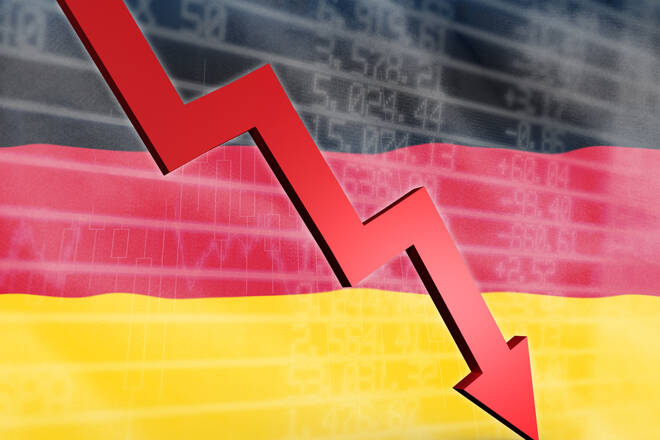Advertisement
Advertisement
European Equities: A Week in Review – 08/04/22
By:
Inflation and FED monetary policy leave the European majors on the back foot, as the war in Ukraine continues with no signs of an imminent ceasefire.
The Majors
It was a mixed week for the European majors in the week ending April-8, 2022.
The EuroStoxx600 rose by 0.57%, while the CAC40 and the DAX ended the week with losses of 2.04% and 1.13%, respectively.
Market angst over FED monetary policy and the ongoing Russian invasion of Ukraine weighed on demand for riskier assets.
Economic data from the Eurozone delivered mixed results, which failed to offset market sentiment toward FED monetary policy.
News updates on China’s lockdowns to curb the spread of COVID-19 added to the negative sentiment in the week.
The Stats
It was a busy week, with the markets focused on service sector activity and the German economy.
Stats from Germany delivered mixed results. In February, Germany’s trade surplus widened from €8.9bn to €11.5bn, with industrial production up 0.2%. Factory orders slid by 2.2%, however, to test support.
Service sector PMIs were more upbeat. France and Germany saw service sector activity pickup, while Italy and Spain saw activity moderate. Despite this, the Eurozone’s services PMI rose from 55.5 to 55.6. As a result of disappointing manufacturing numbers, the Eurozone’s composite PMI fell from 55.5 to 54.9.
On Thursday, the ECB monetary policy meeting minutes also drew interest.
In line with expectations, policymakers discussed cutting back on stimulus to curb inflation. Policymakers noted that “three forward guidance conditions for an upward adjustment of the key ECB interest rate had either already been met or were very close to being met.”
Despite the need to curb inflation, the war in Ukraine left policymakers on a more cautious footing.
From the U.S
In the first half of the week, economic data included factory orders and service sector PMIs.
The stats were mixed. Factory orders fell by 0.5% in February, partially reversing a 1.5% rise from January, while service sector activity improved.
In March, the market’s preferred ISM Non-Manufacturing PMI increased from 56.5 to 58.3.
On Thursday, jobless claims were also impressive. In the week ending April-01, initial jobless claims fell from 171k to 166k.
While the stats were market positive, the FOMC meeting minutes weighed. More hawkish than anticipated minutes hit the global equity markets. The minutes revealed plans to begin cutting the FED balance sheet by $95bn per month amidst a rising interest rate environment to curb inflation.
The Market Movers
From the DAX, it was a bearish week for the auto sector. Volkswagen and BMW slid by 2.88% and 2.53%, respectively, with Continental falling by 2.24%. Daimler ended the week with a more modest 0.43% loss.
It was a mixed week for the banking sector. Deutsche Bank ended the week up 0.19%, while Commerzbank fell by 3.20%.
From the CAC, it was a bearish week for the banks. Credit Agricole and Soc Gen slumped by 9.43% and 10.41%, respectively. BNP Paribas slid by 7.43%.
Things were also bearish for the French auto sector. Stellantis NV and Renault ended the week down 6.92% and 9.26%, respectively.
Air France-KLM and Airbus saw losses of 3.27% and 6.86%, respectively.
On the VIX Index
A four-week losing streak ended for the VIX in the week ending April-08.
Reversing a 5.67% fall from the previous week, the VIX rose by 7.79% to end the week at 21.16.
2-days in the green from 5 sessions, which included a 13.25% jump on Tuesday, delivered the upside.
In the week, the NASDAQ 100 slid by 3.86%. The Dow and the S&P500 fell by 0.28% and 1.27%, respectively.
The Week Ahead
It is a busy week ahead on the Eurozone economic calendar.
ZEW Economic Sentiment figures for Germany and the Eurozone are out on Tuesday. The markets will likely accept another deterioration in sentiment as Russia continues to bomb Ukraine.
On Wednesday, Eurozone industrial production figures will also draw attention.
The main event of the week, however, is the ECB monetary policy decision. A shift in stance on interest rates to curb inflation would test support for the majors.
Finalized inflation figures for member states are also due out. We don’t expect the numbers to materially influence the majors, however.
From the U.S, inflation figures are due out on Tuesday. Expect plenty of market sensitivity to the numbers following last week’s hawkish FOMC meeting minutes.
On Wednesday, wholesale inflation figures will also draw interest ahead of a busy end of the week.
With the markets closed on Friday, retail sales, consumer sentiment, and jobless claims will influence this Thursday. A slump in consumer spending, a rise in jobless claims, and a fall in consumer sentiment would be market risk negative.
Economic data from China will also provide direction, with inflation and trade data due out.
While the stats and monetary policy will provide direction, news updates on the war in Ukraine will remain the key driver.
About the Author
Bob Masonauthor
With over 28 years of experience in the financial industry, Bob has worked with various global rating agencies and multinational banks. Currently he is covering currencies, commodities, alternative asset classes and global equities, focusing mostly on European and Asian markets.
Advertisement
